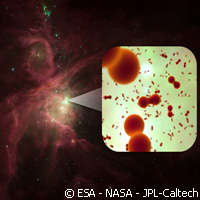Sigh of relief for astronomers on oxygen space search
An international team of astronomers has made the first undisputed detection of oxygen molecules in space. Using data from the European Space Agency's (ESA) Herschel space observatory, the largest astronomical telescope ever launched, the Herschel Oxygen Project team was able to see molecules of oxygen in the nearby Orion star-forming complex. This new research, published in The Astrophysical Journal, solves a mystery that has puzzled astronomers for decades. Although previous studies have shown that atomic oxygen exists in warm regions of space, until now no searches have turned up oxygen in its molecular form - two atoms of oxygen bonded together. Although these telescopic readings helped piece together part of the jigsaw, they still left many questions unanswered, which the team were determined to address. For example, the observed amount of atomic oxygen was far less than that expected; where is all the oxygen in the cold clouds hiding? In trying to explain the lower-than-expected oxygen level, astronomers suggested that oxygen atoms may freeze onto tiny dust grains found floating in space and be converted to water ice, which effectively removes them from sight. If this is true, the ice should evaporate in warmer regions of the cosmos, returning water to the gas and allowing molecular oxygen to form and to be seen. To test their hypotheses, the team used Herschel's Heterodyne Instrument for the Far Infrared (HIFI) and targeted Orion, where they reasoned that the forming stars would heat the surrounding gas and dust. Using three infrared frequencies of the instrument, the Herschel Oxygen Project team was successful. They found there to be one molecule of oxygen for every million hydrogen molecules. Paul Goldsmith, lead author on the study and NASA's Herschel project scientist at NASA's Jet Propulsion Laboratory in Pasadena, California comments: 'This explains where some of the oxygen might be hiding. But we didn't find large amounts of it, and still don't understand what is so special about the spots where we find it. The Universe still holds many secrets.' Oxygen, in all its forms, is the third most abundant element in the Universe and a major ingredient of our planet. It is found in our atmosphere, oceans and rocks, and is critical for life itself because we inhale its molecular form. Yet how it acts in space remains mysterious. Whilst this study has made groundbreaking steps in the search for oxygen, the search certainly continues. Göran Pilbratt, another study author and ESA's Herschel project scientist, reflects on their work: 'Thanks to Herschel, we now have an undisputed confirmation that molecular oxygen is definitely out there. There are still many open questions but Herschel's superior capabilities now enable us to address these riddles.' Herschel was launched on an Ariane 5 ECA rocket from Europe's spaceport in Kourou, French Guiana, on 14 May 2009. It was launched together with ESA's Planck spacecraft. Herschel is designed to perform routine science operations for a minimum of three years. The mission will end when the helium used to cool the focal plane of the scientific instruments is depleted, which is predicted to happen sometime between late 2012 and spring 2013. Space observatories are necessary for the simple reason that the Earth's atmosphere blocks most infrared wavelengths, making it impossible to view stars from Earth.For more information, please visit: European Space Agency: http://www.esa.int/esaCP/index.html
Countries
Switzerland, Germany, Spain, France, Netherlands, Sweden, United Kingdom, United States



